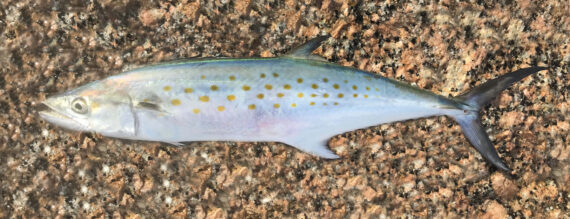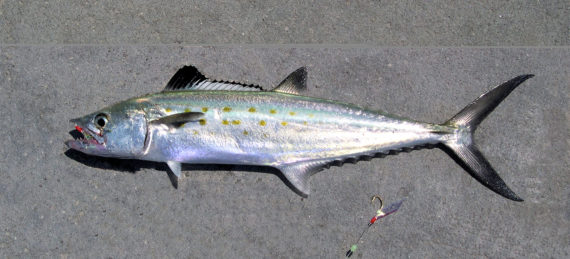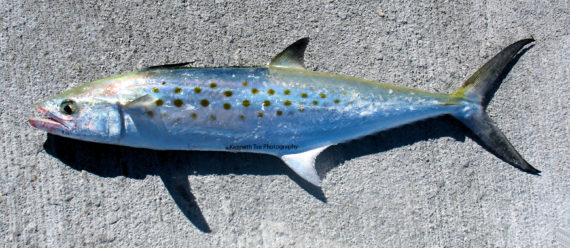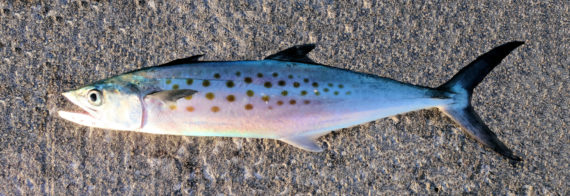Spanish Mackerel, Scomberomorus maculatus
 Spanish Mackerel, Scomberomorus maculatus, Juvenile. Fish caught from beach of Pompano Beach, Florida, July 2019. Length: 10 cm (3.9 inches). Catch, photograph and identification courtesy of Luke Ovgard, Klamath Falls, Oregon.
Spanish Mackerel, Scomberomorus maculatus, Juvenile. Fish caught from beach of Pompano Beach, Florida, July 2019. Length: 10 cm (3.9 inches). Catch, photograph and identification courtesy of Luke Ovgard, Klamath Falls, Oregon.
 Spanish Mackerel, Scomberomorus maculatus, Juvenile. Fish caught from beach of Pompano Beach, Florida, July 2019. Length: 18 cm (7.1 inches). Catch, photograph and identification courtesy of Luke Ovgard, Klamath Falls, Oregon.
Spanish Mackerel, Scomberomorus maculatus, Juvenile. Fish caught from beach of Pompano Beach, Florida, July 2019. Length: 18 cm (7.1 inches). Catch, photograph and identification courtesy of Luke Ovgard, Klamath Falls, Oregon.
 Spanish Mackerel, Scomberomorus maculatus. Fish caught from the Packery Channel Jetty, Corpus Christi, Texas, September 2018. Length: 33 cm (13 inches). Catch, photograph and identification courtesy of Luke Ovgard, Klamath Falls, Oregon.
Spanish Mackerel, Scomberomorus maculatus. Fish caught from the Packery Channel Jetty, Corpus Christi, Texas, September 2018. Length: 33 cm (13 inches). Catch, photograph and identification courtesy of Luke Ovgard, Klamath Falls, Oregon.
 Spanish Mackerel, Scomberomorus maculatus. Fish caught from coastal waters off Tampa, Florida, April 2011. Length: 34 cm (13 inches). Catch, photograph, and identification courtesy of Ryan Crutchfield, Tampa, Florida.
Spanish Mackerel, Scomberomorus maculatus. Fish caught from coastal waters off Tampa, Florida, April 2011. Length: 34 cm (13 inches). Catch, photograph, and identification courtesy of Ryan Crutchfield, Tampa, Florida.
 Spanish Mackerel, Scomberomorus maculatus. Fish caught off the Sanibel Fishing Pier, Sanibel Island, Florida, February 2021. Length: 34 cm (13 inches). Catch, photograph and identification courtesy of Marc Eberlein, Grand Rapids, Michigan.
Spanish Mackerel, Scomberomorus maculatus. Fish caught off the Sanibel Fishing Pier, Sanibel Island, Florida, February 2021. Length: 34 cm (13 inches). Catch, photograph and identification courtesy of Marc Eberlein, Grand Rapids, Michigan.
 Spanish Mackerel, Scomberomorus maculatus. Fish caught from coastal waters off Honeymoon Island State Park, Florida, December 2013. Length: 36 cm (14 inches). Catch, photograph and identification courtesy of Kenneth Tse, Toronto, Canada.
Spanish Mackerel, Scomberomorus maculatus. Fish caught from coastal waters off Honeymoon Island State Park, Florida, December 2013. Length: 36 cm (14 inches). Catch, photograph and identification courtesy of Kenneth Tse, Toronto, Canada.
 Spanish Mackerel, Scomberomorus maculatus. Fish caught off a coastal waters off Tampa, Florida, December 2013. Length: 46 cm (18 inches). Catch, photograph, and identification courtesy of Ben Cantrell, Peoria, Illinois.
Spanish Mackerel, Scomberomorus maculatus. Fish caught off a coastal waters off Tampa, Florida, December 2013. Length: 46 cm (18 inches). Catch, photograph, and identification courtesy of Ben Cantrell, Peoria, Illinois.
The Spanish Mackerel, Scomberomorus maculatus, is one of the most common members of the Mackerel or Scombridae Family, that is also known as the Atlantic Spanish Mackerel and in Mexico as sierra común. Globally there are eighteen species in the genus Scomberomorus, of which five are found in Mexican waters, three in the Atlantic and two in the Pacific Ocean.
The Spanish Mackerel has an elongated, strongly compressed, fusiform, and torpedo-shaped body. They are greenish-blue dorsally and transition to silvery white ventrally and on their lower sides. Their first dorsal fin is black. Their sides have 3 or 4 rows of numerous elliptical yellow to bronze spots with larger fish having more spots than smaller fish. Their head has a short pointed snout and a modest-sized mouth that extends to the rear margin of the eyes and is equipped with a single row of large, uniformly-sized, closely-spaced teeth on each jaw. Their anal fin does has 16 to 20 rays and is followed by either 8 or 9 finlets; their caudal fin is deeply forked with 1 large and 2 smaller keels at its base; their first dorsal fin has 17 to 19 spines; their second dorsal fin has 17 to 20 rays and closely follows the first and is higher and similar in shape to the anal fin, and is followed by 8 or 9 finlets; and, their pectoral fins are short. They have 11 to 16 gill rakers. Their body is covered with small scales and their lateral line gradually curves down toward the caudal fin base.
The Spanish Mackerel is a coastal pelagic schooling species found in the subtropical and tropical waters off North America and the Caribbean. They are found from the surface to depths up to 35 m (115 feet) in waters with temperatures between 20oC (68oF) and 30oC (86oF) and travel in large schools near the surface and close to shore. They are dimorphic with females living longer and being larger than males. Females reach a maximum of 1.01 m (3 feet 4 inches) in length and 5.9 kg (13 lbs 0 oz) in weight; males reach a maximum of 48 cm (19 inches) in length. As of January 1, 2024, the International Game Fish Association world record for length stood at 64 cm (2 feet 1 inches) with the fish caught from coastal waters off Marathon, Florida in December 2011. The corresponding world record for weight stood at 5.89 kg (13 lbs 0 oz) with the fish caught in coastal waters off North Carolina in November 1987. The Spanish Mackerel make long seasonal migrations very close to shore moving northward during the summer when water temperatures increase and return in the fall. Juveniles grow rapidly until age 5, then experience slower growth. They are voracious opportunistic predators and consume small fish including anchovies, clupeids, and herrings as well as cephalopods and shrimp on a limited basis. They are preyed upon by larger pelagic fish including sharks and tuna, marine mammals including bottlenose dolphins, and various sea birds. Reproduction is oviparous with each female broadcasting gametes into the water column that are quickly fertilized by males. Eggs are pelagic and generally hatch within 25 hours. Females have lifespans of up to eleven years; males have lifespans of up to six years.
The Spanish Mackerel is a resident of all Mexican waters of the Atlantic including the Gulf of Mexico and the Caribbean but only on a seasonal basis.
The Spanish Mackerel is very similar in appearance to the Cero, Scomberomorus regalis (yellow-orange stripe along mid-flank), the small King Mackerel, Scomberomorus cavalla (first portion of dorsal fin not black; abrupt drop in lateral line mid-body), and the Sierra Spanish Mackerel, Scobmeromorus brasiliensis (absent from Mexican waters, found in Belize waters). It is also virtually identical to the Gulf Sierra, Scomberomorus concolor and the Pacific Sierra, Scomberomorus sierra, both found only in the Pacific Ocean.
From a conservation perspective the Spanish Mackerel is currently considered to be of Least Concern with stable, widely distributed populations. In the United States they are closely monitored and heavily regulated with seasonal closures and daily bag and length limits, however, they are totally unregulated in Mexico. They are a highly sought after commercial and recreational fish. Commercially, they are caught primarily with purse seines at levels of 10,000 tons annually in the southeastern United States as the use of drift gill nets was banned in 1989. They are sold fresh for use in sushi, frozen and smoked, however, they have a very short shelf-life and are known to contain ciguatoxin. I recommend that these fish be consumed the day of catch or not at all. They are strong foes for recreational anglers and caught from boats via trolling or from beaches, drifting boats, piers, and jetties with jigs, spoons, and live bait with the use of wire leaders being essential. They are considered to have a high food value.